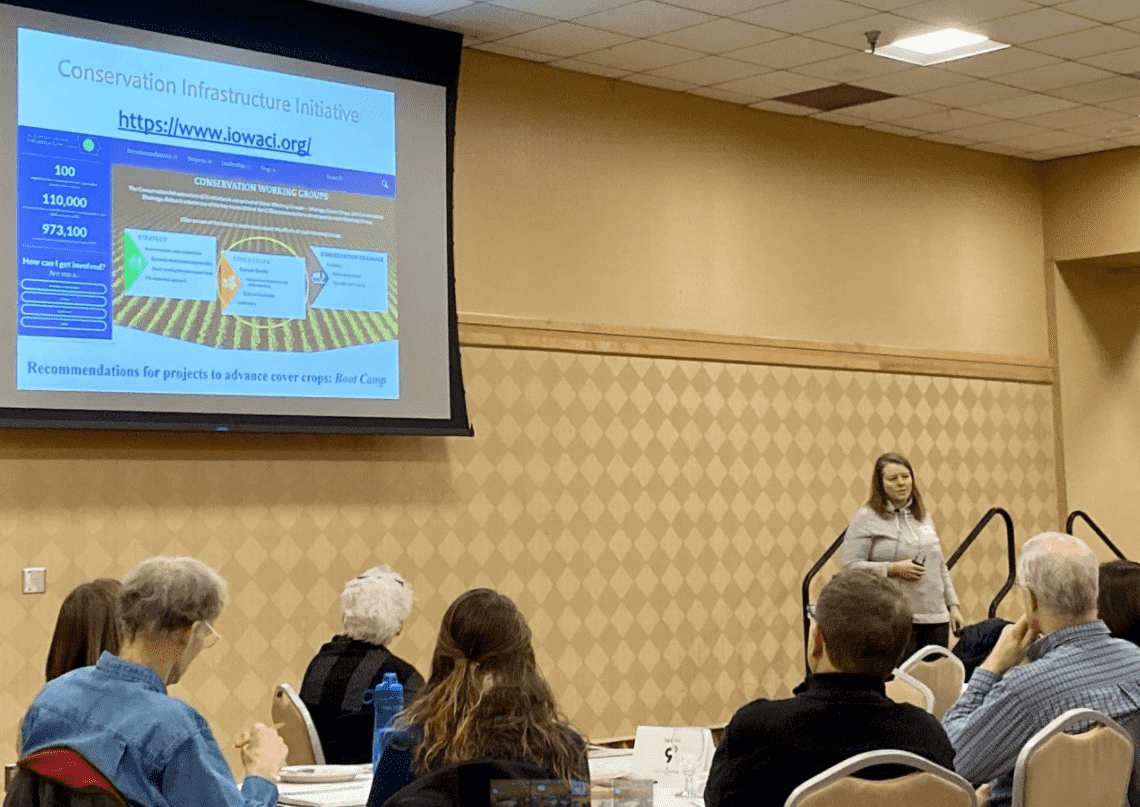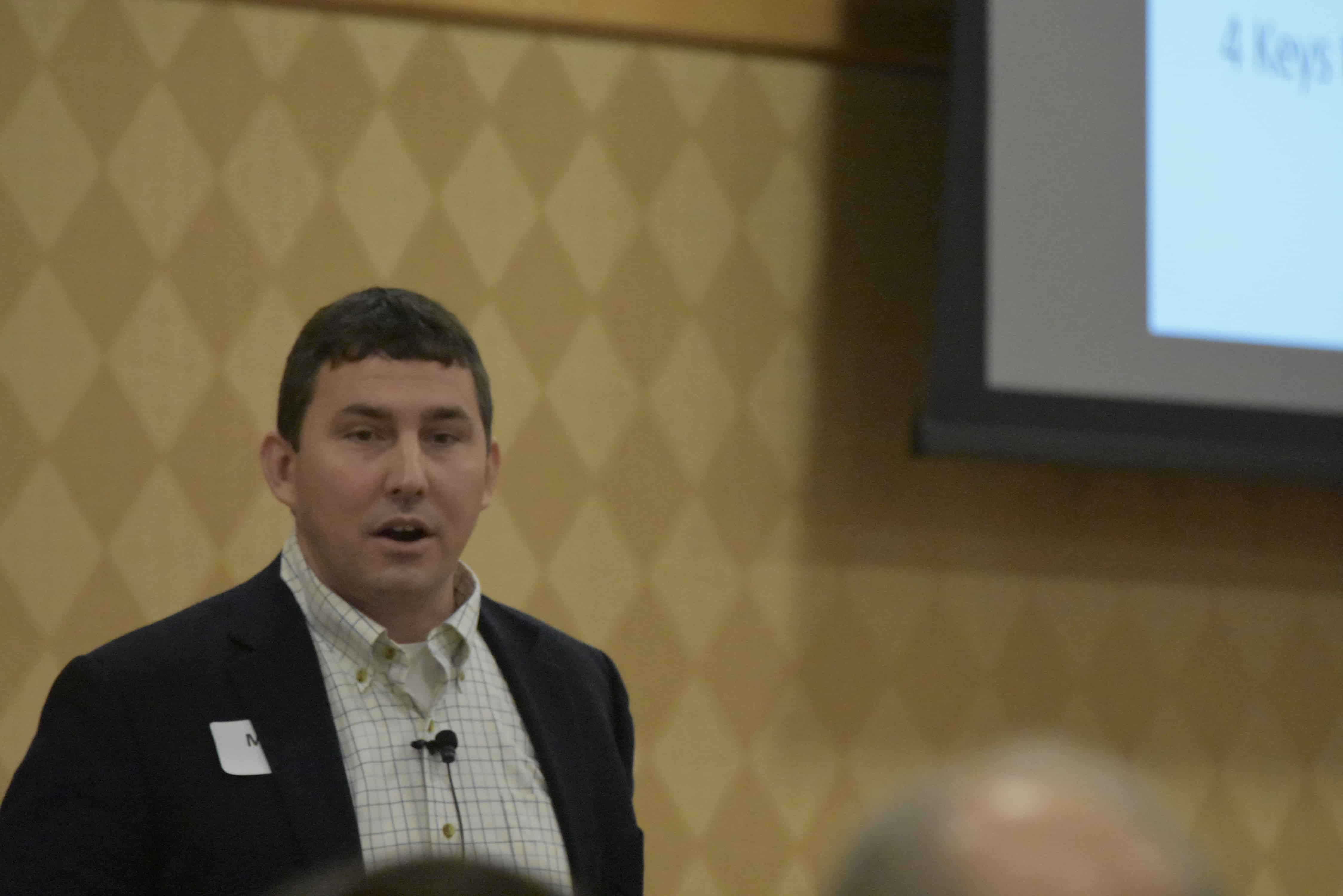By Kurt Lawton
“If you want to succeed at cover crops, you will. If you want to fail at cover crops, you will.” These are examples of some of the honest, direct, farmer-to-farmer wisdom shared at the recent Cover Crops Boot Camp held in Ames.

Finding success, considering challenges, and exploring solutions were among the exercises undertaken by more than 100 farmers gathered at the meeting.
The Boot Camp was one of the key recommendations that came out of the Conservation Infrastructure initiative. The event was led by Sarah Carlson, Practical Farmers of Iowa, with extensive planning phase input from members of the Conservation Infrastructure Cover Crops Working Group (co-led by Sarah and Bert Strayer, La Crosse Seed) and a number of other partners. The event brought together farmers and industry leaders to hone and share their knowledge of cover crop science and management practices.
Some overall lessons learned:
- Change your mindset. Don’t give up on your first stumble; it takes effort to make things work.
- Be honest with cover crop challenges. The learning curve is steep, so start small but try new things. Planting cereal rye ahead of soybeans is a good place to start.
- Cover crops require patience and adaptability, as numerous variables are at play and every season and field is different. Mother Nature still controls success with cover crops.
- Know your goals, set expectations, and work cover crops into your system incrementally.
- Document actions to help plan effectively and make informed decisions for future management.
- Cover crops are not a silver bullet, but they are an important tool in the toolbox.
- Over time, a no-till or strip-till system with cover crops will lead to more forgiving soils.
- Cover crops help weatherproof the farm (i.e., increase water retention, hold soils in place, and increase resilience).
- Cover crops improve soil health by improving soil aggregate stability, increasing soil carbon and organic matter, providing living roots in
 the soil prior to row crops establishment in the spring and post-harvest in the fall when Iowa receives the most precipitation and soils aremost susceptible to nitrate loss and soil erosion. They reduce compaction, improving porosity and infiltration rates and serving as a food source for soil microbes, earthworms, and other soil invertebrates.
the soil prior to row crops establishment in the spring and post-harvest in the fall when Iowa receives the most precipitation and soils aremost susceptible to nitrate loss and soil erosion. They reduce compaction, improving porosity and infiltration rates and serving as a food source for soil microbes, earthworms, and other soil invertebrates. - Cattle feed costs can be reduced in the fall by grazing cover crops and manure can reduce fertilizer input costs. One presentation featured south-central Iowa farmer Mike Jackson, who tag-teamed with Iowa State University Extension croppingsystems specialist Mark Licht to discuss 4 Keys to Success with Cover Crops. The takeaways?
1. Goals: Make goals and keep them realistic.
- Figure out when you’re going to plant, what you’re going to do, and your desired outcome. Jackson wants erosion control and nutrient stabilization. Last spring near Oskaloosa, he had 10 inches of rain in 10 days, and without cover crops the soil would have been halfway to New Orleans by now.
- Set your goals - Do you want cover crop biomass for weed suppression? Feed value for grazing? Improved soil health
- Jackson suggests finding a farmer-mentor who is doing things that match your goals and talk to them. Cover crops force you to change your system, as you just can’t throw them into the current cropping system and expect them to work. Also, find and join some cover crop Facebook groups, alongside your own research and reading.
- Jackson’s long-term goal is to leave his sixth-generation farm to his son, Mack, with better soils and a strong commitment tocontinued land improvement.
2. Equipment Setup: How to deal with cover crop residue in the spring.
- Jackson says that since they don’t strip-till, they keep planter components sharp and up to date.They use spiked closing wheels, working about two inches of the soil — all that’s needed when
 following cover crops.
following cover crops. - Next, get off the tractor and check your planting depth. If there’s an inch of biomass on top of the soil, set the planter deeper.
- Licht says planter settings need a higher focus to succeed with cover crops. You still focus ontoolbar down-
pressure on the row-unit, seeding depth, and closing the seed furrow, but these things become more important. - Adding cover crops is about the same scale of change as transitioning from full tillage to no-till. A 5-10% yield hit could happen if you’re not paying attention to planter setup and performance details.
3. Fertilizer: With cover crops, it’s almost a given that the timing of your N fertilizer will change.
- Licht recommends putting N on in the spring, and when the crop actually needs it. Optimally, total N needs are the same if there is a cover crop or not, it’s just rethinking N timing. You don’t want fall applications taken up by cover crops.
- Jackson says they apply a lot of hog manure and use a shallow vertical-tillage tool to incorporate it. Their second trip in a field is with their corn planter and they put 5-6 lbs. N in-furrow. The third trip is with a sprayer to burndown the cereal rye cover crop. They add 5 lbs. N to help break the rye down. Total N is about 180 lbs. to achieve a 200 to 220 bu. corn yield average.
- Most importantly, they do tissue and soil sampling, as well as some post-harvest stalk nitrate sampling, to ensure they are not overapplying and sending nitrates down to the Gulf.
4. Seeding Methods: There’s a lot of variable ways to seed cover crops, as well as pros and cons. Timing and the environment can dictate the best approach.
- With aerial and broadcast seeding, you can apply earlier and cover more acres faster. The downside is a less uniform stand and poor establishment under dry conditions.
- Drill seeding delivers better and more uniform stands in the right conditions for growth. Jackson likes to drill cover crops following the combine.
- Seeding with a high clearance interseeder delivers more biomass due to earlier seeding with more heat units, usually.Partners who gave time and funding for this event include: Practical Farmers of Iowa (PFI), La Crosse Seed, Coalition to Support Iowa’s Farmers, Iowa Farm Bureau Federation, the Iowa Agriculture Water Alliance, the Iowa Department of Agriculture and Land Stewardship, Iowa Learning Farms, Iowa Corn, Iowa Soybean Association, Iowa Cattlemen’s Association, Iowa Turkey Federation, Iowa Pork Producers Association, Iowa Poultry Association, Iowa Dairy Association, Iowa State University, Soil Health Partnership, Iowa Seed Corn Initiative, Iowa Seed Association, and the Natural Resources Conservation Service.
